The 6th Annual Schofield Bryophyte and Lichen foray was held in and around the vicinity of Squamish, British Columbia, between September 11 and 13, 2015. The small group of participants, which included two students and one six-year old budding bryologist, visited various moist and wet sites in the area.
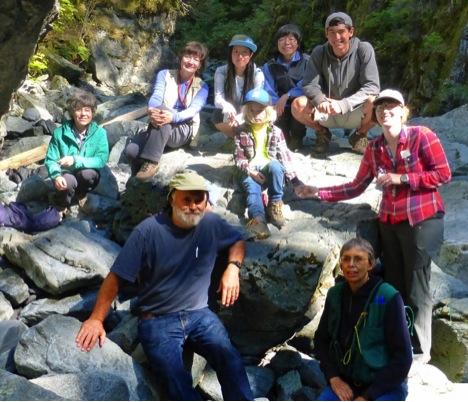
Group at High Falls Creek. Photo by Judith Holm & Wayne Harpel.
Day 1 of the foray centered on the Squamish trail system. The group spent the morning exploring the Woodpecker Trail, near the Squamish Training Dyke area. The species they encountered here were typical of moist coastal forest habitats; among them were common epiphytic pleurocarpous mosses such as Antitrichia curtipendula, Homalothecium fulgescens, Isothecium stoloniferum, Metaneckera menziesii and Neckera douglasii. In all, the group observed 26 species of mosses and 3 species liverworts at the site.
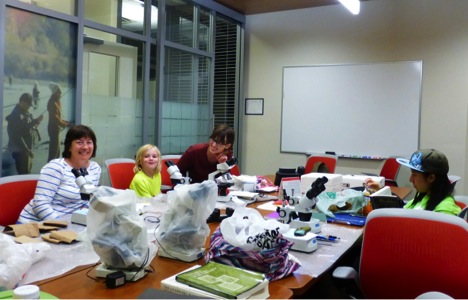
Photo by Olivia Lee.
The second stop of the day was at a slightly more elevated site in the woods near Quest University. The site contained many wet depressions and the group found a few mosses and liverworts that weren’t seen at the earlier site. These included Sphagnum spp. and other mosses such as Buckiella undulata and Hookeria lucens, plus the liverworts Bazzania denudata and Lepidozia reptans. The group later returned to town and spent the evening examining some of the day’s finds using space generously provided by Squamish Savings.
On Day 2 of the foray, the group headed north of town and explored a couple of sites up the Squamish River Valley. At the first stop, the group covered an area a very short distance up the High Falls Creek Trail, just reaching a shady outcrop with large boulders near High Falls Creek. The area contained more rock habitat than the previous day’s sites, and species characteristic of both moist and rather dry sites were observed. Here, the group saw the highest bryophyte species diversity of all the sites they visited, noting no fewer than 53 species of mosses and 9 species of liverworts. Among the species they observed on outcrops and boulders were the mosses Anacolia menziesii (more typical of drier habitats), Bartramia pomiformis, Grimmia torquata, Cynodontium jenneri, Claopodium crispifolium, Isothecium stoloniferum (also on trees), Aulacomnium androgynum, Racomitrium lawtoniae and the liverwort Scapania americana. Another noteworthy observation was that of the occurrence of Tetraphis geniculata and T. pellucida growing in close proximity to one another on a moist, rotten log in the forest. Tetraphis pellucida was also common on rotten wood throughout the area.
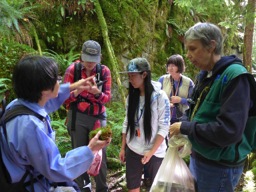
Photo by Judith Holm.
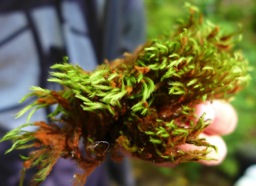
Anacolia menziesii. Photo by Judith Holm.
After leaving the High Falls Creek Trail, the group crossed a bridge over the west side of the Squamish and explored an area of forest near the road to the Ashlu River Channel system. At this site, the aquatic moss Hygrohypnum ochraceum was found growing on a log in the flood zone of the river, and some common liverworts such as the thalloid species Pellia neesiana were encountered for the first time. Afterwards, the group reconvened at the Brackendale Art Gallery for a bite to eat and to examine some of the specimens they had collected earlier in the day.
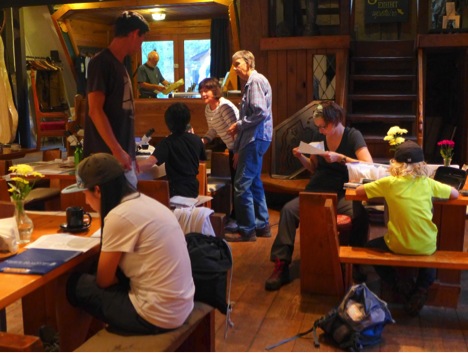
Brackendale Art Gallery. Photo by Judith Holm
The third and final day of the foray was spent back closer to the town of Squamish. In the morning, four members of the group made a brief visit at the trail north of the Adventure Centre to check on the status of a colony of Brotherella roellii, an uncommon moss that had been found there a few years previously. Unable to find any Brotherella, they determined that it had likely been displaced by more aggressive species.
The other three remaining foray participants went to the Mamquam Reunion Spawing Channels to see some of the successful work of the Squamish Wetland Society towards the recovery of a salmon spawning channel there while at the same time to make observations about the local bryophyte community. Overall, they observed only minor differences between the species composition at this site and the other sites they had visited during the foray.
As the foray was winding down, a few participants made final stops at Shannon Falls and Stawamus Provincial Parks. These parks contained liverwort species such as Herbertus aduncus and Tetralophozia filiformis, which were not present at any of the other the sites visited during the foray. The foray concluded with a ride up the Sea to Sky Gondola and a short walk through the Wonderland Trail to briefly explore some higher elevation habitats. Here, four Sphagnums and more species of liverworts were observed on the forest floor and in various other microhabitats. In addition to the many bryophyte sightings, the group also encountered what is apparently the trail’s resident Pygmy Owl.
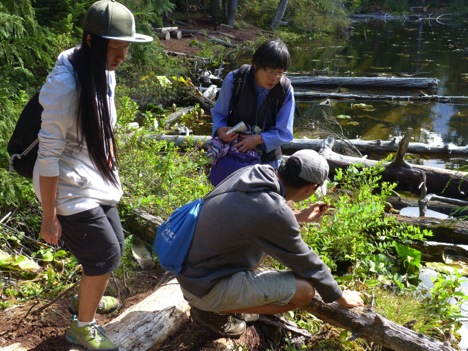
Wonderland Lake. Photo by Judith Holm.
Acknowledgments
Post edited by Steve Joya.
The organizer would like to thank the following individuals for making the 6th Annual Wilf Schofield Bryophyte foray a success:
Judith Holm for her help in locating places for the group to meet at in the evenings: Squamish Savings’ board room (Day 1) and The Brackendale Art Gallery (Day 2).
Edith Tobe, Executive Director of Squamish River Watershed Society for introducing us to many of the wet sites in the area.
